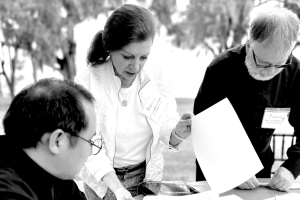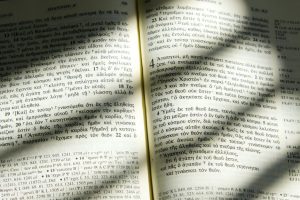My husband and I were engaged in December 2019. We quickly chose our venue and selected a wedding date: January 23, 2021. Then, of course, March 2020 ushered in a global pandemic. Like many “COVID couples,” my husband and I had to decide whether to postpone our wedding. Would we regret not having our larger community of family and friends bear witness to our vows? Or was this an invitation to have an intimate wedding Mass where we proclaimed our vows to each other in a private ritual? We chose the latter.
On our wedding day, I walked myself down the aisle. As I waited in the back of the church, I felt strong, stable, grounded, and focused. I took my husband’s hand, he led me to our place in front of the altar, and we began our journey together as a married couple.
“Do you promise to be true to her/him in good times and in bad, in sickness and in health, to love her/him and to honor her/him all the days of your life?”
When two people promise to be true to each other in this way, they hope to have a lifetime together, in good health and happiness. What I didn’t anticipate when I made those vows was that chronic illness would bring new challenges into our life together.
Almost a year after our wedding, we did have our large reception and chose to renew our vows. It is not common for a young couple to renew their vows just one year after getting married, but we loved having the opportunity to share parts of our liturgy from the year before, specifically the reading from the Book of Ruth.
In this story, Naomi is a woman in mourning. Her husband and two sons have died, and she tells her two daughters-in-law to return to their homes, because they have no reason to remain with her. But Ruth replies, “Where you go, I will go; where you lodge, I will lodge; your people shall be my people and your God my God. Where you die, I will die, and there will I be buried” (1:16–17).
When Naomi realizes that Ruth is determined to go with her, she stops urging her. They become one family and go out into the world together, resolved never to turn their backs on each other. What a beautiful illumination of the power of a vow.
In his homily, our priest, a close family friend, reminded us that in the marriage rite, husband and wife vow before God and the Christian community to love, honor, and cherish each other and to be faithful in good times and in bad. “Say to one another what Ruth proclaims to Naomi,” he said.
When my husband and I recited our vows, we held so much joy in our hearts as we anticipated what the life ahead of us would look like. We had our health. We were fully able. We were ready. What could happen to a couple in their early 30s?
Two years into marriage we moved from New York City to Connecticut. I accepted a role in mission leadership in Catholic health care. A new job is stressful, and during the first few weeks I noticed difficulty swallowing and intermittent slurred speech. I fought through it, thinking I needed to find a new outlet for stress relief. A short time later, I noticed growing fatigue that impacted my work. Eventually, my symptoms became more intense, and our vow of “in sickness and in health” began to emerge in a new way.
After several doctors and no answers, we found ourselves meeting with a neuromuscular specialist who told me that I have myasthenia gravis (MG). While it was a relief to have a name for what I was experiencing, the name meant nothing to me. As we learned more in the coming days, we quickly realized this was going to change us, quite frankly, forever.
MG is a rare neuromuscular autoimmune disease. Within the first year of diagnosis, I was hospitalized three times. I quickly went from walking with some tiredness to using a cane to becoming dependent on a walker and to now needing an electric wheelchair. I have already undergone one surgery and tried several different treatments, all in the hopes that one will bring stability to and easing of my symptoms.
When my husband and I reflect on the vow “in sickness and health,” we realize we had a very narrow understanding of what that meant. I think we expected the vow to mean we would support each other if one of us received a terminal diagnosis or if one of us lived with a sickness that lasted for a period of time but did not result in death. Such beliefs were based on our lived experiences.
My father passed away at age 57 from cancer. I watched my mother accompany him during that time, and I experienced a manifestation of God’s love through their embodiment of this marriage vow. When suffering and grief were at my family’s doorstop, my mother’s faith only increased. My parents were Ruth and Naomi. They did not turn from each other, but their love for each other intensified. I am so grateful to have experienced this.
I am chronically ill; I would not say that I am “sick.” At times I experience sickness from my illness. For example, post-infusion therapy I get flu-like symptoms. With some medications I experience nausea and increased fatigue, but those small sicknesses subside and pass. What remains is MG, and that disease is here to stay.
When my husband and I said “in sickness and in health,” we hoped sickness would come much later in life, rather than in the first three years of marriage. We do not doubt God remains close to us in our suffering, but it is difficult to keep that at the center of our lives when the chaos of medication management, doctors’ appointments, work priorities, and the everyday realities of life with chronic illness weigh on our physical and mental health.
I think about the confidence and physical stability with which I walked myself down the aisle on my wedding day. How could I have ever imagined just a few years later I would use a wheelchair and be completely dependent on others? My husband and I have learned that becoming chronically ill challenges the wording of traditional vows. We realized the dichotomy of “in sickness or health” is limiting and not reflective of the reality of many married couples.
If sickness has no endpoint, how do you, as a couple, evolve? I know couples who have separated after years of trying to learn to live with a chronic illness. This is not really what anyone would sign up for, yet at the same time a vow is not simply an agreement. Rather, it is the sacred commitment to honor and love each other unconditionally. These vows mandate each person to embrace the many realities that await them in a lifetime together.
Admittedly, there have been times when I thought it might be better if my husband were set free from our vows. It felt as if my MG was trapping him, forcibly taking him away from things he wanted to do. That almost hurt me more than MG. Chronic illness is a heavy cross that many bear. Many of us will never get an answer as to “why,” so the idea of “fairness” seeps in, not just for me, but for my caregivers.
In a moment of deep despair, I said to my husband, “Don’t you want to be free of this?” His reply completely surprised me. He said, “Where you go, I will go; where you lodge, I will lodge; your people shall be my people and your God my God. Where you die, I will die, and there will I be buried.”
We chose this reading for our wedding in a time of consolation and anticipation of the life ahead, hoping that we would always stay close and true to each other. However, in our desolation and lived experience with chronic illness, we find ourselves interpreting the story with greater nuance and complexity. We do not just want to emulate Ruth and Naomi; we are Ruth and Naomi. The words Ruth proclaims to Naomi are now the words we profess to each other as a married couple. They are our new vows.
This article also appears in the August 2024 issue of U.S. Catholic (Vol. 89, No. 8, pages 19-20). Click here to subscribe to the magazine.
Image: Unsplash/Nathan Dumlao













Add comment